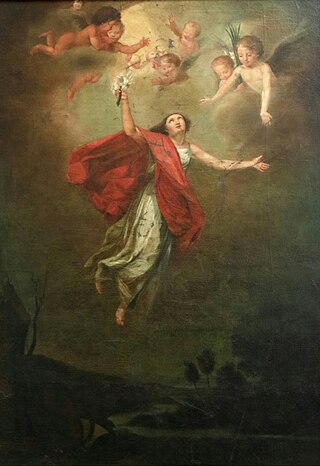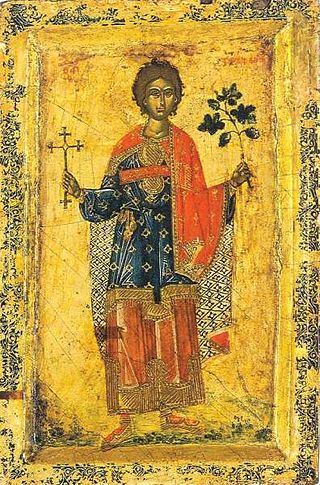
Philomena, also known as Saint Philomena or Philomena of Rome was a virgin martyr whose remains were discovered on May 24–25, 1802, in the Catacomb of Priscilla. Three tiles enclosing the tomb bore an inscription, Pax Tecum Filumena, that was taken to indicate that her name was Filumena, the English form of which is Philomena. Philomena is the patron saint of infants, babies, and youth, and is known as "The Wonderworker".

The calendar of saints is the traditional Christian method of organizing a liturgical year by associating each day with one or more saints and referring to the day as the feast day or feast of said saint. The word "feast" in this context does not mean "a large meal, typically a celebratory one", but instead "an annual religious celebration, a day dedicated to a particular saint".

Saint Valentine was a 3rd-century Roman saint, commemorated in Western Christianity on February 14 and in Eastern Orthodoxy on July 6. From the High Middle Ages, his feast day has been associated with a tradition of courtly love. He is also a patron saint of Terni, epilepsy and beekeepers. Saint Valentine was a clergyman – either a priest or a bishop – in the Roman Empire who ministered to persecuted Christians. He was martyred and his body buried on the Via Flaminia on February 14, which has been observed as the Feast of Saint Valentine since at least the eighth century.

Margaret, known as Margaret of Antioch in the West, and as Saint Marina the Great Martyr in the East, is celebrated as a saint on 20 July in Western Christianity, on 30th of July by the Eastern Orthodox Church, and on Epip 23 and Hathor 23 in the Coptic Orthodox Church.

Ursula was a Romano-British virgin and martyr possibly of royal origin. She is venerated as a saint in the Roman Catholic Church and the Anglican Communion. Her feast day in the pre-1970 General Roman Calendar and in some regional calendars of the ordinary form of the Roman Rite is 21 October.

Saints Faith, Hope, and Charity, are a group of Christian martyred saints who are venerated together with their mother, Sophia ("Wisdom").

May 27 - Eastern Orthodox Church calendar - May 29
Cyriacus, sometimes Anglicized as Cyriac, according to Christian tradition, is a Christian martyr who was killed in the Diocletianic Persecution. He is one of twenty-seven saints, most of them martyrs, who bear this name, of whom only seven are honoured by a specific mention of their names in the Roman Martyrology.

July 5 - Eastern Orthodox Church calendar - July 7

July 23 - Eastern Orthodox liturgical calendar - July 25

December 31 - Eastern Orthodox liturgical calendar - January 2

January 17 - Eastern Orthodox liturgical calendar - January 19

February 11 - Eastern Orthodox liturgical calendar - February 13

Saint Tryphon of Campsada was a 3rd-century Christian saint. He is venerated by the Roman Catholic and Eastern Orthodox churches as a great martyr and holy unmercenary.

Martinian and Processus were Christian martyrs of ancient Rome. Neither the years they lived nor the circumstances of their deaths are known. They are currently buried in St. Peter's Basilica in Rome.

Saints Victor and Corona are two Christian martyrs. Victor was a Roman soldier who was tortured and killed; Corona was killed for comforting him. Corona is invoked as a patron of causes involving money; she was not historically associated with pandemics or disease, but has been invoked against the coronavirus pandemic.

Agapitus is venerated as a martyr saint, who died on August 18, perhaps in 274, a date that the latest editions of the Roman Martyrology say is uncertain.

The title Virgin is an honorific bestowed on female saints and blesseds, primarily used in the Eastern Orthodox Church and the Catholic Church.

Christina, born Yazdoi, was a Sasanian Persian noblewoman and Christian venerated after her death as a virgin martyr.

Dorothea of Caesarea is a 4th-century virgin martyr who was executed at Caesarea Mazaca. Evidence for her actual historical existence or acta is very sparse. She is called a martyr of the late Diocletianic Persecution, although her death occurred after the resignation of Diocletian himself.

















